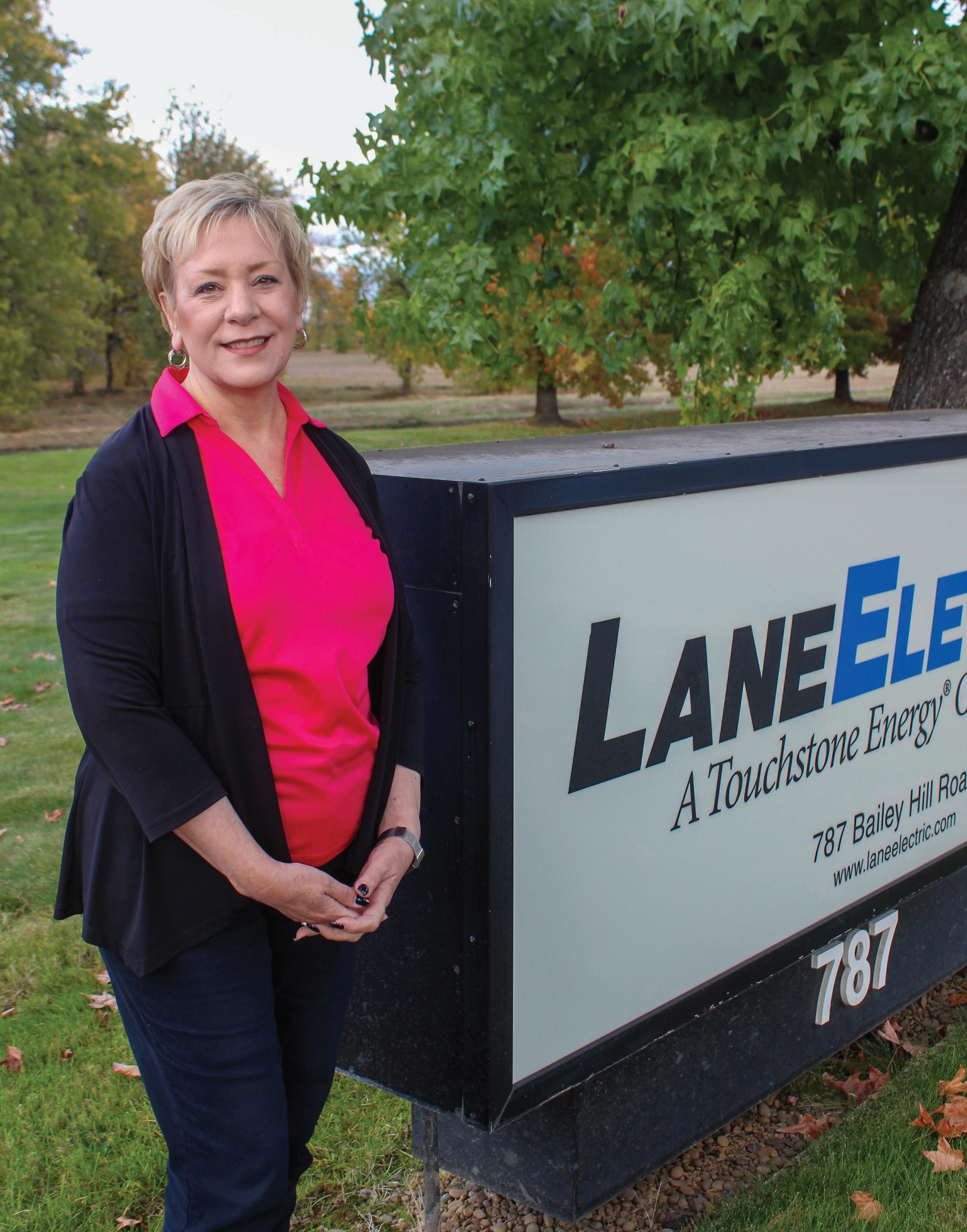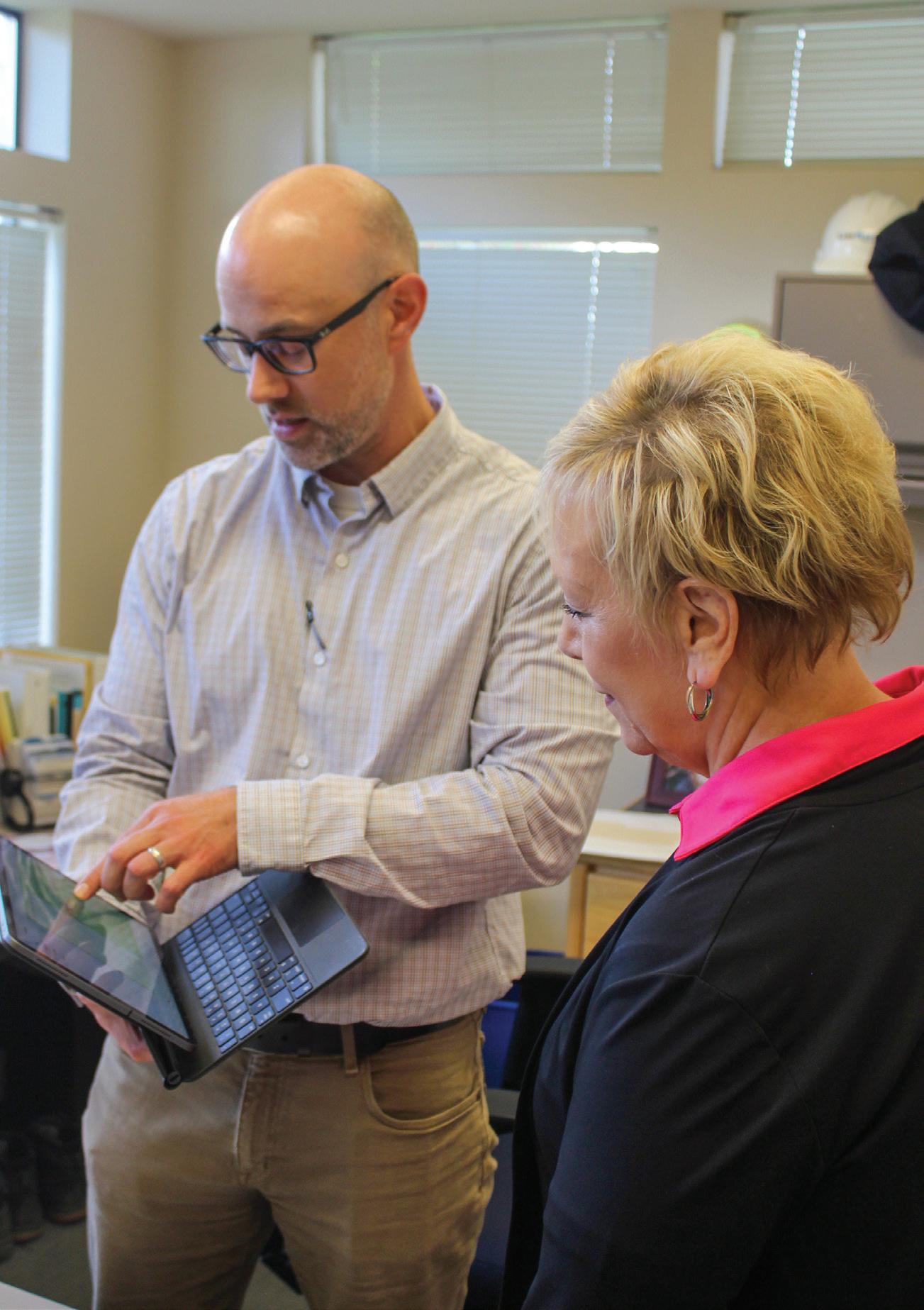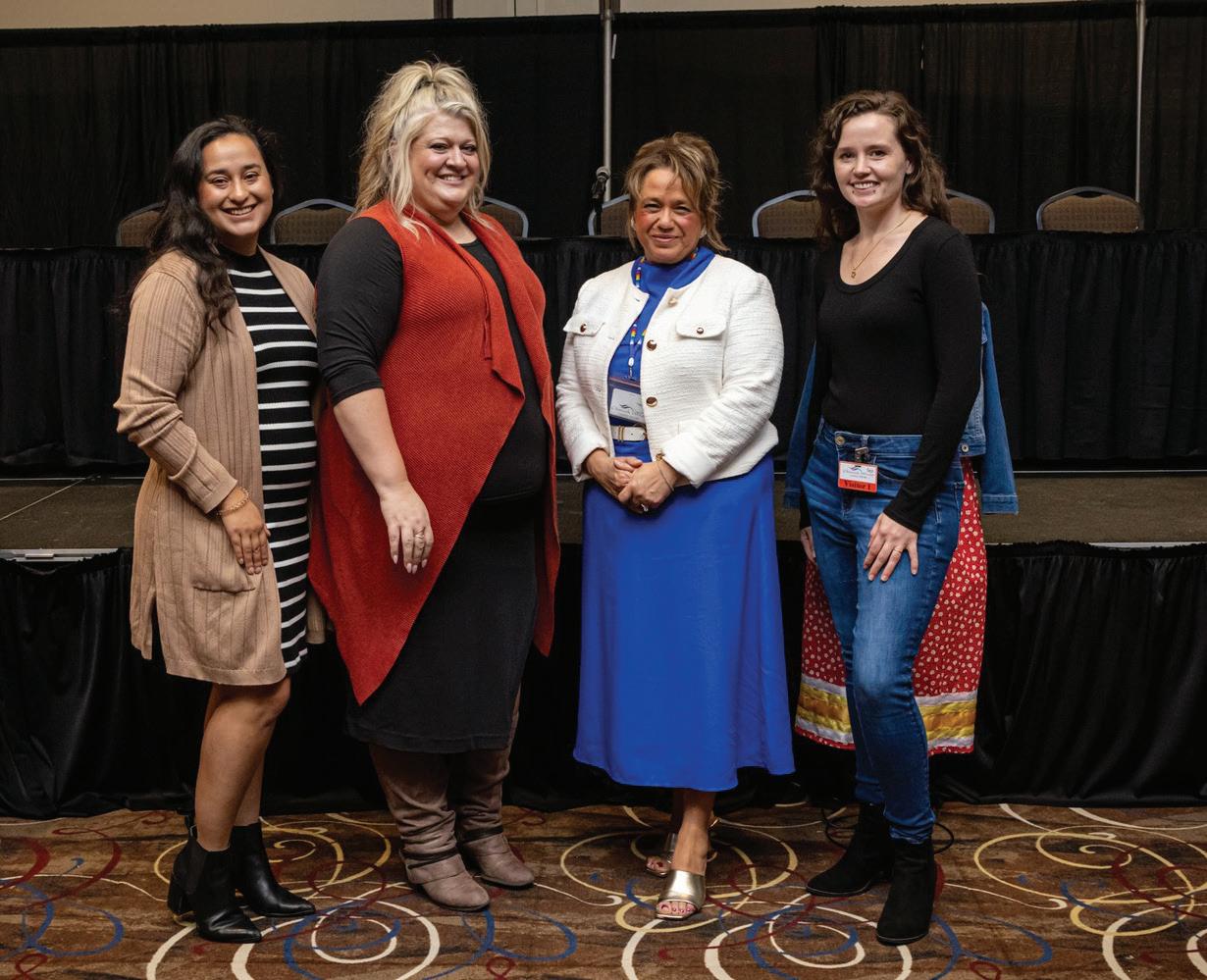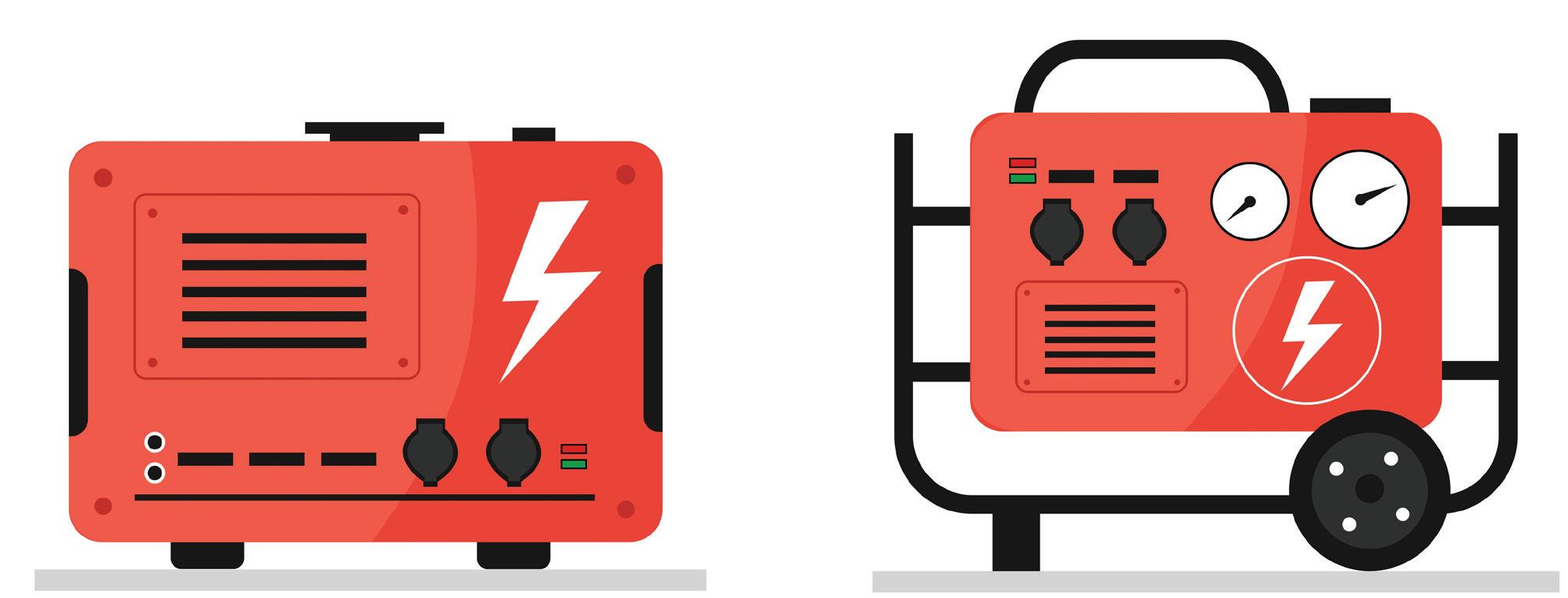








On this enchanting 9-day cruise from Charleston to Amelia Island, experience the charm and hospitality of the South. In the comfort of our modern fleet, travel to some of the most beautiful historic cities in America. The fascinating sites you visit, the warm people you meet, and the delectable cuisine you taste, come together for an unforgettable journey.
Small Ship Cruising Done Perfectly






























January 2025 • Volume 72, No. 1
CEO Michael Shepard
SENIOR VP OF CONTENT Leon Espinoza
EDITORIAL DIRECTOR Chasity Anderson, CCC
DEPUTY EDITORIAL DIRECTOR
Noble Sprayberry
SENIOR EDITOR Jennifer Paton, CCC
ASSISTANT EDITORS Victoria Hampton, CCC; David Herder CCC
ASSOCIATE EDITORS
Valeri Pearon, Nina Todea
PUBLICATIONS PRODUCTION SR. MANAGER
Elizabeth Beatty
SENIOR PUBLICATIONS COORDINATOR
Alyssa McDougle
Ruralite (USPS 397-460) is published monthly for members for $5.43 per year, plus postage, by Pioneer Utility Resources Inc., 5625 NE Elam Young Pkwy. Ste. 100, Hillsboro, OR 97124—a not-for-profit Oregon cooperative corporation—to serve the communication needs of 46 consumer-owned electric utilities in Oregon, Washington, Alaska, Idaho, Nevada and California. Preferred periodical postage paid at Hillsboro, Oregon, 97123 and additional mailing offices. © 2025 Pioneer Utility Resources. All rights reserved. Reproduction in whole or in part without written permission is prohibited.
Postmaster Send address changes to Ruralite, 5625 NE Elam Young Pkwy. Ste. 100, Hillsboro, OR 97124-6454
HOW TO CONTACT RURALITE
Subscription services:
Nonmember subscriptions $15 (U.S.) per year; $25 per year (foreign). Prepayment required. Allow 4-8 weeks for first issue. Be sure to identify which local edition you want to receive.
Address Changes:
Utility members, contact your local utility. Subscribers, call us at 503-357-2105 option 3 or email mailingdept@pioneer.coop.
Back issues:
Back issues and extra copies $3. Prepayment required. Supply is limited. Be sure to identify edition, month and year. Call first if ordering back issues to check availability.
To contact Ruralite: Ruralite magazine is published by Pioneer Utility Resources. P.O. Box 1306, North Plains, OR 97133-1306; 503-357-2105; email: info@pioneer.coop. For more information, visit www.pioneer.coop.
DISPLAY ADVERTISING INQUIRIES
American MainStreet Publications
611 S. Congress Ave., Ste. 504 Austin, TX 78704
800-626-1181 or 512-441-5200
As the new year unfolds, it brings with it the promise of fresh starts and new opportunities. Many of us take this time to reflect on the past year and set resolutions for the months ahead.

Whether it’s pursuing personal growth, building stronger relationships or contributing to our communities, this annual reset reminds us change is always possible. I hope that in this season of renewal, you find the strength and courage to achieve your resolutions and embrace the potential for transformation in your own life.
Yet, alongside the optimism, we must also acknowledge the importance of facing life’s more difficult truths. Sometimes, the stories that break our hearts are the ones that teach us the most. They remind us of the resilience of the human spirit and the power of hope to overcome even the darkest of circumstances.
One such story is that of Jane, a survivor of human trafficking, whose journey exemplifies courage, determination and the profound impact of community support.
Jane’s story, as told by our very own awardwinning writer Victoria Hampton, is a sobering reminder that trafficking often doesn’t look like the stereotypes we might imagine. It’s not confined to far-off cities or shadowy strangers. It
can occur in the homes and neighborhoods we think we know best.
Despite the horrors she faced, Jane’s journey didn’t end in despair. Her eventual escape and recovery were made possible by the tireless efforts of local advocacy groups and community task forces that refused to let her story go unheard. Today, she works to support other survivors, channeling her experiences into advocacy and care. Her resilience and resolve serve as a beacon of hope for countless others who face similar struggles. Read more on Page 10.
As we step into this new year, let us take inspiration from Jane’s journey and the work of those who supported her. Consider how you might contribute to change in your own community. Whether it’s volunteering, donating time, supplies or money, or simply raising awareness, every effort matters. The new year is a time for hope, resolve and action. Together, we can create a world where every individual has the opportunity to rewrite their story and dream of brighter days ahead.
Thank you for the wonderful story ideas many of you submitted in the past month. I’m still following up on many of them. Have additional thoughts about a story we should share? Reach me at editor@pioneer.coop.
Happy New Year!
Chasity Anderson Editorial Director

For supplemental and interactive content, search @Ruralite on your favorite social media sites.

Plugged
a Voice to the Silent Community task forces create first lines of defense against human trafficiking in rural communities
Spotlight, Page 10
In The Kitchen, Page 16


Story and photos by Craig Reed
Debi Wilson describes her career at Lane Electric Cooperative as “never a dull
But then she adds she would have liked one.
Debi announced her retirement in November after a 26-year career at the cooperative. She has been the general manager for the past five years.
“No disasters in my final months is my wish,” she says, hoping for some dull moments.
Debi says highlights in her time as general manager have been snow storms, ice storms and wildfires. There was also COVID-19 shortly after she accepted the general manager position in 2019.
“Through most of my career, there has been a major winter storm about every other year,” Debi says. “When those events happen, something almost magical happens. The staff comes together in a unique way to serve the members and get the power restored.
“These last five years have been filled with all kinds of challenges, but the co-op staff’s response has been outstanding.”
Lane Electric Cooperative has 45 employees who monitor and maintain about 13,000 electric meters across about 2,600 square miles.
“Debi took the reins of Lane Electric just prior to Snowmageddon (in 2019) and was able to lead the cooperative through our first FEMA event,” says Susan Knudsen Obermeyer who was the co-op’s board president during Debi’s GM time until last July. “It was followed by several more events including COVID and wildfires. Her passion for Lane Electric and its members has always been her driving force. Debi has given her all for 26 years. It was a pleasure to work with her.”
Kris Martes, the board’s current president, says she has seen firsthand Debi’s dedication and devotion to the cooperative.
“I think it is important to recognize the amazing challenges Debi overcame to keep Lane Electric moving forward these past years,” Kris says. “As the general manager, she has been at the forefront of dealing with some of the most trying times. She led Lane Electric through the devastations of the 2020 fires and then in 2024, the worst ice storm to hit Lane County. Debi made sure the cooperative responded and restored the system as quickly and as
Board member Chris Seubert agrees Debi has been the co-op’s go-to person
during the storms and fires that resulted in power outages.
“She’s been the person who has been there and done the callouts and the follow-ups,” Chris says. “She’s been there 100%. She’s had a commitment to the co-op.”
Debi’s commitment to Lane Electric began in 1998 after working 10 years for a CPA firm in Eugene. She graduated from Bend Senior High School and attended the University of Oregon, earning a degree in accounting. When Debi saw the co-op was advertising for an accounting position, she thought it looked “extremely interesting.” She recalls that she was ready for a change and wanted to use her skills to benefit one business.
Debi worked through several positions at the co-op—controller, finance and administration manager—before accepting the general manager job. When Debi was hired, Ron Schwada was the finance and administration manager. He included Debi in managerial decisions and potential business opportunities and introduced her to other aspects of the co-op.
Then-General Manager Rick Crinklaw also gave Debi opportunities to learn more about the co-op beyond her own job duties. She was included in board meetings and in the planning for future projects.
“A co-op needs engineering, linemen, energy services, office staff—all are needed to serve the members,” Debi says. “I worked with a lot of people who basically told me what they did. Rick set a great example to follow.”
In recent years, Debi has been on the board of directors of the Pacific Northwest Generating Cooperative and Lane Electric’s representative on the Public Power Council and the Northwest Public Power Association. Lane Electric is a member of the National Rural Electric Cooperative Association, an organization that has given Debi additional contacts for discussions on co-op issues.
“It’s nice to have those people to reach out to, particularly when it comes to advocacy,” she says.
During her co-op career, Debi is credited with obtaining several disaster recovery grants and funding following the major outage events to help with expenses, rebuild infrastructure, put lines underground rather than overhead, install overhead insulated wire and develop wildfire mitigation plans. Placing fire retardant wraps around wooden power poles is scheduled for the near future.
Kris says Debi had the foresight to submit applications and secure millions of dollars in FEMA and grant funding for fire mitigation and infrastructure improvements.
“Debi recognized the importance of securing and developing a

long-range plan for technological advancements needed to replace an aging metering system,” Kris says.
“My recommendation to the staff is to keep applying for those grants,” Debi says. “Do what you can to get that funding.”
Debi also credits her team and board for continually working to improve the cooperative.
“I do get to work with great people every day,” she says.
“Working together to advance the co-op is fun. We have a lot of younger people here now, and that’s the future of Lane Electric.”
Kris says Debi made safety a priority for the co-op’s employees.
“I cannot thank Debi enough for her dedication and devotion to Lane Electric Cooperative,” she says.
The co-op board has hired a national firm to conduct a search for a replacement for the general manager position.
Once Debi retires, she plans to travel and visit her sister who lives in Mozambique, Africa. The sisters plan to visit Norway, the homeland of their grandfather before he immigrated to the United States.
“I’ll be able to enjoy winter and summer without being concerned about whether the power is staying on,” Debi says. “But my heart will always be here.” n
Give your home an annual safety checkup to stay a step ahead of electrical fires
By David Herder
Being home can mean having a warm and cozy spot to rest while winter weather rages outdoors. However, your home can turn from toasty to toast in an instant if a fire breaks out.
Electrical failures and malfunctions were factors in more than 46,000 fires a year from 2015-2019, according to the National Fire Protection Association. Annually, those fires caused 390 deaths, 1,330 injuries and $1.5 billion in property damage.
The new year presents an opportunity to build new habits and safeguard your home. Give your home an electrical safety checkup to keep it how you like it—warm, safe and free of electrical fire hazards.
Cords and plugs are responsible for about 7% of deaths in home fires, despite only being involved in 1% of home fires, according to the NFPA. Extension cords are the most common cause of plug- or cord-related fires. Take these precautions with your cords:
• Check all cords for damage or fraying. These issues are fire and shock hazards.
• Don’t put weight on cords. Placing chairs or other heavy objects on cords can damage them.
• Only use extension cords temporarily. If you need electrical access in a different spot, consider contacting a licensed electrician to install new outlets.
• Plug large appliances directly into outlets, never into extension cords.
• Wires inside of walls can be dangerous as well. Check for loose wall receptacles, wires or lighting fixtures, and listen for popping or sizzling sounds behind walls.
Many electrical hazards are caused by faults—abnormal electric currents. Left untreated, these can cause shock and fire hazards. Using arc-fault and ground-fault circuit interrupter outlets can save your life. Ground faults are where electricity has an abnormal path, creating a shock hazard. Make sure you have GFCI outlets anywhere that could become wet—including the bathroom, kitchen and any outdoor outlets.
Arc faults often cause overheating in wires and electric equipment. Common culprits are pinched, damaged or overloaded wires. AFCI outlets shut off when they detect unwanted arcing. AFCIs are useful in all living areas.
Most electrical fire deaths occur in December and January, according to the United States Fire Administration. This is also the time of year when we use space heaters, wood stoves and other heating devices. Heating devices can become dangerous when used improperly. Keep these tips in mind when using heating devices:
• Keep anything that can burn at 3 feet away from heating equipment, such as furnaces, space heaters, fireplaces or wood stoves.
• Only use products as intended. Space heaters are not for drying clothes, and the cooking stove is not a heater.
• Ensure all fuel-burning heating equipment is vented to the outdoors, and keep all intake and output vents clean and clear of debris.
• If using a wood stove or fireplace, use a screen to prevent sparks from flying into the room.
• Never plug a space heater into an extension cord.
• Keep space heaters on level ground, away from areas where you may trip over it.
Many people use portable generators during outages. To properly use one:
• Let the generator run for a couple of minutes before plugging things in to prevent catastrophic surges. Similarly, plug things in one at a time, as each device requires a small surge to start up.
• Only plug generators in to your home’s transfer switch or into a heavy duty extension cord rated for the weather conditions. Never plug generators into wall outlets—this can endanger lineworkers by backfeeding electricity onto distribution lines.
• Keep generators at least 20 feet from your home to prevent carbon monoxide poisoning. n




Many new devices enter our homes during the holidays, and that means new batteries to charge. Lithium-ion batteries are efficient and effective at powering phones, toys, electric bikes and more, but they can be fire hazards.
Damaged lithium-ion batteries can rapidly overheat and ignite. Whatever you’re plugging in, safe charging can prolong your battery life and prevent fire danger.
X Stop using a battery if you notice any smell, change in color or shape, too much heat, leaking or odd noises.
X Plug battery chargers directly into a wall outlet.
X Don’t overload circuits. Batteries take in a lot of energy while charging. Make sure you don’t overload your home’s circuits by having too much plugged in at once.
X Charge in a flat, dry area, away from sunlight and doorways. Heat and water can create fire risks, and keeping batteries away from exits keeps emergency paths clear should a fire start.
X Always buy batteries from known, quality sellers.
X Stay near your batteries while they are charging.

The Lane Electric Nominating Committee— comprised of members from around our service territory—will soon be accepting applications for the cooperative’s board of directors. In 2025, two directors are up for reelection: one representing the Central District and the other representing the Row River District. The incumbent

in the Central District is seeking reelection while the Row River position is uncontested.
If you live in these districts and are interested in serving your electric cooperative, you can learn more at laneelectric.com/districts-directors/applications.
The deadline to apply is Thursday, March 13. n
Visit laneelectric.com/districts-directors/applications for more information about running for the Lane Electric Board of Directors.
PHOTO BY BRO VECTOR


























Minimum order of 5 coins
GENERATIONAL WEALTH is of paramount significance as it represents a beacon of financial stability. It serves as a tangibletestament to the hard work, diligence, and financial acumen of previous generations, offering a solid foundation upon which future generations can build their dreams and aspirations. $299ea.
American Gold Reserve is releasing Government issued $5 Gold American Eagles completely free of dealer mark-up for only $299 each. These beautiful $5 Gold American Eagles are a perfect way to enter the gold market. They are set for immediate public release and will sell out fast
• Free of dealer markup.
• Protection against inflation and deflation.
• Gold offers financial cover during geopolitical uncertainty.

hours - 7 days a week
• Good portfolio diversifier.










By Victoria Hampton
As a child, Jane was an explorer. While the wind whipped through her brown hair and the sun beat down on her family’s rural central California ranch, Jane and her brothers created imaginary worlds. Goats and chickens acted as companions on their quests, and trees and forts built their magical realms.
Yet even the most elaborate games of make-believe only offered temporary escapes from the cruelties of Jane’s everyday life.
“I was about 6 years old when my cousin started to traffick me for drugs,” says Jane, now 33.
It was not a villain from a faraway city who stole Jane away from her family and forced her into a life of human trafficking. It was Jane’s cousin and grandfather who forced her into illicit acts for her family’s financial gain in the small town where she grew up.
“Looking back on it, it was a very slow process of isolating me and manipulating me and grooming me to the point where I thought that what I was doing was helping my family,” Jane says.
Jane’s experience is similar to millions of victims who are bought and sold for commercial sex and forced labor in the United States. Nonprofits and task forces throughout the Northwest are taking action against this crime to help victims and survivors as well as safeguard their communities. People like Jane are no longer alone in their fight for a better life.
“Human trafficking is one of the fastestgrowing criminal enterprises in the world,” says Amanda Swanson, Oregon Department of Justice’s human trafficking response and intervention coordinator. “Before the pandemic, it had surpassed the gun trade and was projected to surpass the drug trade. Human trafficking, you really can break down to economics 101. If there is demand, somebody is going to supply.”
From her 16 years of experience working hundreds of human trafficking cases in Oregon, Amanda knows the crime is perpetrated by people who victims know, trust and sometimes love.
“The top two most common forms of trafficking are familial trafficking and romantic relationships,” Amanda says. “It’s the family. It’s a partner. It’s a boyfriend or girlfriend. It’s not the person who is going to jump out of the bushes. It’s possibly our neighbor or a family member.”
Familial trafficking is when a trafficker exploits a minor within their own family. Other traffickers exploit their partners or spouses. In both scenarios, perpetrators manipulate their victims and prey on their vulnerabilities. Traffickers offer safety, security and basic needs that may be lacking in someone’s life.
“Most of the time, there is a lot of stuff going on at home, whether it is abuse or neglect from their family,” Jane says. “They feel like they don’t have those basic, fundamental things we all need as humans, like love and acceptance.”

Using a process of force, fraud and coercion, traffickers build up individuals, making them dependent on their abusers. They use this control they’ve gained to force people into illicit acts. By the time this happens, victims have no way out.
“A lot of times people still think, ‘How could somebody get trapped into this?’”
Jeri MooMaw says. “The grooming process is similar to a cult leader. Over time, (traffickers) are cutting off any other avenue of needs fulfillment so (victims) become dependent on them.”
Jeri—a child sex trafficking survivor and executive director of Innovations Human Trafficking Collaborative—has worked with clients who live everywhere from gated communities to homeless encampments.
“When you’re being forced to do things that you don’t want to do—besides the physical pain that you go through—I think it is just a really difficult thing to cope with mentally. There was a point where my brain just kind of broke.”
JANE, HUMAN TRAFFICKING SURVIVOR


Human trafficking affects victims from all age groups and walks of life.
Once a trafficker has effectively isolated their victim, they use tactics of fear, shame and helplessness to keep them in the life. For Jane—a child who did not know a lifestyle beyond the one she lived on her family’s isolated ranch—traffickers used fear as their tool to keep her compliant.
“They told me that people could read my mind, and I believed that,” Jane says. “My brothers would be hurt if I didn’t do what they would ask me to do.”
In communities, trafficking happens under the radar.
“Especially in rural communities, (trafficking) doesn’t always look like the way we think it would,” Jane says. “I
wasn’t standing on street corners. I lived at home with my family. Most of my trafficking happened in people’s homes.”
Jane’s abuse continued throughout her childhood while she went to school, played sports and attended church. She seemed like any other child, with a shy and obedient nature.
“One part of me was doing all this terrible stuff, and the other part of me was who I kind of presented to the world,” Jane says. “If you had looked at me, you wouldn’t think, ‘This person is being trafficked.’”
Jane was terrified of what might happen if she opened up to anyone about her abuse. Her cousin—the same one selling her for sex—introduced her to substance abuse to help cope with the
trauma and physical abuse inflicted by her buyers and to make her easier to control.
“When you’re being forced to do things that you don’t want to do—besides the physical pain that you go through—I think it is just a really difficult thing to cope with mentally,” Jane says. “There was a point where my brain just kind of broke. It’s incredibly difficult to process.”
She also started self-harming and attempted suicide multiple times. Jane was connected to a school counselor and saw a therapist. While she was too scared to speak her truth, no one recognized the signs of what was going on behind closed doors.
“Nobody ever asked me why,” Jane says. “I don’t understand why nobody saw the bigger picture.”


To help mitigate this crime in local communities, county task forces are relying on what small towns do best: help one another. County task forces are community-based multidisciplinary teams with the training and skills to identify, respond to, and help victims and survivors of human trafficking.
Each task force is different but often includes employees from the local police department, domestic violence and housing assistance organizations, youth nonprofits, school districts and other county organizations with existing resources to support victims and survivors.
“Our goal is to have them in every county,” says Amanda, who is responsible for building Oregon’s response to sex and labor trafficking.
This effort starts with building awareness and understanding the root causes of trafficking and how it thrives in communities. From there, task forces find the best ways to support victims and survivors by pooling resources and educating their communities about human trafficking and where they can direct suspected victims for help or report a suspected incident.
“One of the goals of the task force is
to build this team of people who know what trafficking is and know how to respond to it so that when a victim or survivor is identified, they know what to do and the other agencies they can reach out to support the person,” says Ashley Johnson, Anti-Trafficking Alliance of Central Oregon task force coordinator and “at:project” coordinator.
If a victim is in a police station, entering foster care, contacting a domestic violence center or sitting in a school counselor’s office, the goal is for the professionals they’re encountering to know how to identify the signs of trafficking and connect them with what they need in the moment.
Starting with meeting basic needs— something to eat and a safe place to rest— may lead to counseling, housing and job support, or prosecution of their trafficker.
Community awareness and collaboration changed Jane’s life.
After escaping her traffickers in her early 20s, Jane eventually found her way to Central Oregon. Even through the trauma and abuse Jane experienced, she didn’t think of herself as a survivor.
“At this point, I still didn’t understand what trafficking was,” Jane says. “I didn’t know that was what had happened to me. I knew it was a lot of abuse and a lot of really
bad things that shouldn’t have happened.”
When she moved to Oregon, Jane was in an abusive relationship and struggling with her mental health. While working in a hospital, she suffered from a concussion after hitting her head on a piece of equipment. During her medical examination, the doctor found evidence of multiple concussions Jane had suffered from abuse inflicted by her traffickers and buyers.
Finally, someone asked Jane a question that took down all the walls she’d spent her lifetime building: Why did this happen to you?
“I just broke down and told him everything,” Jane says. “That was the first time I had really opened up about the things I had been through in my life. Up until that point, I was too scared. I told myself I was never going to tell anyone what had happened.”
Thanks to the local advocacy and awareness efforts by the county task force, the doctor knew where to direct Jane to get the help she needed. Jane was connected to at:project, a local nonprofit created by law enforcement and the district attorney’s office employees, service providers and agencies to support survivors of human trafficking in Central Oregon.
The at:project helped Jane gain her
“Getting connected with the at:project was probably the best thing that has ever happened to me.”
JANE
independence and a new outlook on life through therapy, housing assistance and the support of others who understood what she was going through and were there to support her every step of the way.
“Getting connected with the at:project was probably the best thing that has ever happened to me,” Jane says. “I had true, genuine, caring support for the first time in my life, and I feel like that was the turning point for me, and everything just got so much better.”
As a former homeless youth in Lincoln County, Oregon, Lizzie Martinez has firsthand experience of the transformative nature of community support for people experiencing hardship. This inspired Lizzie to dedicate her career to giving back to her community. Lizzie is the Lincoln County Trafficking Intervention Task Force coordinator and works for Children’s Advocacy Center of Lincoln County.
“Just the strength and resilience that I have seen as I’ve walked alongside survivors makes it very motivating to advocate for them in the professional arena and be a voice where they so often don’t have one,” Lizzie says.
Protecting communities from these crimes goes back to where the exploitation of children and adults often starts: vulnerabilities. Lizzie understands everyone has a different capacity to help in their communities, yet there is power in every action taken to raise awareness and support existing programs that help the most vulnerable members of communities.
From small to large, there are ways residents can address vulnerabilities and help safeguard their communities:
• Listen to survivors’ stories at thelifestory.org.
• Donate to a food bank.
• Volunteer at a school as a tutor.
• Donate clothes to youth and adult organizations.
• Research and share internet safety training resources with families. The school district may have resources available.
• Support a domestic violence or housing assistance organization.
• Report any suspected incidents of human trafficking to police.
• Organize a trafficking awareness event, such as a film screening or guest speaker. Contact a county or state antitrafficking agency for training support.
• Volunteer with Court Appointed Special Advocates or a youth advocacy organization.
• Do not buy or encourage others to buy sex.
• Form a task force with programs and services that can support victims and survivors of human trafficking. It can start with a group of concerned community members meeting at someone’s house and expand from there, which is how the Anti-Trafficking Alliance of Central Oregon was formed.
“Being able to address those vulnerabilities makes such a big difference that people don’t even realize,” Amanda says.
A decade later, Jane is still an explorer, and her reality is a place she no longer has to escape from. She takes her lived experiences and helps victims and survivors as a supervisor at an antitrafficking organization in Central Oregon.
“Something that I’ve realized doing this kind of work is how many people have stories similar to mine,” Jane says.
Jane is working on a degree in social work and plans to apply to a master’s program to continue supporting others and be a voice for change.
“I feel like it is a way of taking some of my power back,” Jane says. “Everything that I am learning right now is helping me feel even more confident and capable in my ability to show up for other people.” n

Want to find out more? Listen to Jeri Moomaw, Innovations Human Trafficking Collaborative executive director, speak about holding perpetrators accountable at ruralite.com/giving-a-voice-to-the-silent.
Contact the National Human Trafficking Hotline
This 24-hour, confidential hotline connects victims and survivors of sex and labor trafficking with services and support to get help and stay safe.
If you need assistance, here’s how you can connect:
Call: 888-373-7888
Text: 233733 (BEFREE)
Chat: humantraffickinghotline.org/chat
If you suspect potential situations of sex and labor trafficking in your community, call the hotline or report it to your police department.

At
By Victoria Hampton

Jennifer Geisler knows that anyone who steps into one of her buses could be a human trafficking victim. As chief operations officer of Sunset Empire Transportation District in Astoria, Oregon, Jennifer and her team rely on their yearly training from TAT—formerly known as Truckers Against Trafficking—and open communication to keep their riders safe and get them the help they need.
In February 2023, Jennifer’s team quickly responded to a situation involving two girls who boarded a bus in Seaside to connect with a person they met online in Portland. Calls to the Seaside transit office came from the dad of one of the girls and local police. Transportation Support Specialist Stephanie Rodriguez reviewed camera footage and contacted Jennifer and supervisor Rick Yelton to confirm the girls were on board. Jennifer, Rick, bus driver Chuck Poellnitz and police worked together to bring the girls home.
Jennifer can’t help but think about what might have happened.
“This could very well have not been a happy ending had we not been able to get involved,” Jennifer says. “That’s why we continue to do training every year, to be able to help save our children and other young people as well as elderly and disabled who are just as much of a victim in this situation. It’s just watching out for each other.”
Jennifer credits TAT’s free training to raising her team’s awareness and ability to help riders in need.
Human trafficking is a crime in which people are bought and sold for forced labor or commercial sex. For more than a decade, TAT has worked alongside the transportation industry to bring awareness to this crime and empower drivers to report incidents they see on the road.
“It makes our drivers consciously aware of these situations, and they have the tools to call and question what’s happening,” Jennifer says.
Kylla Lanier couldn’t have imagined how her family’s life would change when she cracked open a book from her mom. She and her sisters were consumed by a world they didn’t know existed when they read David Batstone’s “Not for Sale: The Return of the Global Slave Trade and
“I’ll be honest, we were just shocked,” Kylla says. “We didn’t realize slavery still existed.”
It was this awareness that drove the family to create TAT. What started as local advocacy in 2009 grew into a specialized training program focused on drivers who travel the 4.2 million miles of highways in the United States.
“Most truck drivers, if they knew what was going on, they’d do something about it,” Kylla says, TAT’s deputy director and senior director of external affairs.
Today, the organization offers free human trafficking awareness training for transportation employees—such as longhaul truckers, delivery drivers and public transit drivers—along with law enforcement, government agencies, private and public companies, and community members.
“The general population in the United States, they do not understand prostitution,” Kylla says. “Almost every person in prostitution is there against their will. This is a system of exploitation.”
The exploitation of girls, boys, women and men isn’t the sensationalized experience people see in movies, Kylla says. Victims are often trafficked by people they know who rely on psychological manipulation to



trick and threaten them into providing commercial sex or forced labor. It is a crime that happens everywhere.
“It’s happening in every community, whether people want to acknowledge it or not,” Kylla says. “It is important we are aware and make sure our community is safe. It is an everywhere problem, so it is an everyone solution.”
TAT’s free training includes industryfocused, documentary-style videos, corporate and community training resources, printable posters and wallet cards, and a mobile app. The training videos bring together survivors’ firsthand accounts and antitrafficking education.
TAT’s survivor-driven education changed Oregon Department of Transportation’s Maureen McNeill’s perspective on her work eight years ago when she attended Kylla’s presentation at a law enforcement conference in Bend. During the presentation, a young human trafficking survivor shared some of her darkest moments and how she carries the weight of those experiences with her every day.
“I sat right across the table from her as she told her story, and it really stuck with me for a long time,” Maureen says. “I said to
TOP: Sunset Empire Transportation District’s employees are trained to identify signs of human trafficking. PHOTO COURTESY OF SUNSET EMPIRE TRANSPORTATION DISTRICT RIGHT: Kylla Lanier gives a presentation on human trafficking awareness to 300 law enforcement officers at the 2022 Western States Information Network. PHOTO COURTESY OF TAT
myself, ‘I need to do something about this.’”
As the backbone of the country’s economy, Maureen knows each truck driver she meets may encounter human trafficking victims and perpetrators. Traffickers use the same extensive road network as truck drivers to transport their victims, including the rural stretch of I-84 Maureen manages from Umatilla to Baker City.
“They are the eyes of the road,” she says. “When they’re stopping in rest areas, truck stops and casino parking lots, they are likely to see something.”
When Maureen was promoted to Blue Mountain regional manager of commerce and compliance, she added human trafficking awareness to trainings she and her team present to trucking businesses and farming operations in Eastern Oregon. She has fliers and wallet cards at weigh stations

for her employees to hand out to drivers.

“Traffickers are on our highways, and they need to stop and use facilities,” Maureen says. “That’s where we’re going to spot them.”
Kylla hears stories of industry professionals across the country who have encountered suspected human trafficking and reported it to local police. Oftentimes, the people who step up to help in these situations never hear the outcome of their efforts. Yet, Kylla knows how much of a difference these actions make from the survivors she works with at TAT.
“When you see survivors thriving— these are creative, strong, smart people that deserve a chance at a better life,” Kylla says. n
Bring attention and advocacy to your community with TAT’s free human trafficking awareness resources at tatnonprofit.org.
Acai Bowl With Whole-Wheat Toast
1 100-milligram frozen acai smoothie pack
1 cup low-fat milk
1 medium frozen banana, sliced
1 cup fresh or frozen mixed berries

2 slices whole-wheat bread
Fresh blueberries
Granola
Coconut flakes
Under warm water, thaw frozen acai smoothie pack about 5 seconds. In a blender, combine acai, milk, banana and mixed berries. Blend until smooth.
Toast bread slices to desired doneness.
Pour acai mixture into bowl and garnish with blueberries, granola and coconut flakes before serving. Serve with toast.
Source: Culinary.net
Chicken and Grape Cauliflower Rice Bowl
Chicken
1/2 tablespoon olive oil
1 teaspoon minced garlic
1 teaspoon minced ginger
1 teaspoon ground cumin
1/2 teaspoon turmeric
Zucchini
Salt, to taste
Pepper, to taste
1 pound (3 to 4 pieces) small boneless, skinless chicken breast halves
1 tablespoon olive oil 2 medium zucchini, trimmed and cut into 3/4-inch chunks
Cauliflower rice
1 pound thawed frozen riced cauliflower
1 tablespoon olive oil
1 medium onion, chopped
1/3 cup water
1 teaspoon turmeric
2 large garlic cloves, minced
2 teaspoons minced ginger
1 tablespoon ground cumin
15-ounce can garbanzo beans, drained and rinsed well
1/3 cup chopped fresh cilantro
Salt, to taste
Pepper, to taste
11/3 cups halved red grapes
To make the chicken: In a medium bowl, combine oil, garlic, ginger and cumin. Add turmeric, season lightly with salt and pepper, and whisk to blend. Lightly pound chicken pieces to even them out, then coat in oil-spice mixture. Let stand 20 to 30 minutes.
Heat a large skillet over medium-high heat until hot. Add chicken, smooth side down. Cook until golden brown underneath, about 4 minutes. Flip with spatula, and reduce heat to medium. Cook about 4 minutes until just cooked through. Transfer chicken to a plate and tent with foil. Do not clean the pan.
To make the zucchini: In a medium skillet, heat oil on medium-high heat until hot. Add zucchini pieces. Cook, stirring often until crisp and tender, about 4 minutes. Remove from heat.
To make cauliflower rice: In a colander, drain cauliflower well. In same large skillet used for chicken, add oil, onion and water over medium heat. Cook, stirring until softened, about 3 minutes. Add turmeric, garlic, ginger and cumin. Cook, stirring, for 3 minutes. Add drained cauliflower and garbanzo beans. Cook until hot, about 5 minutes. Stir in cilantro. Season with salt and pepper.
Divide cauliflower rice among four large soup bowls. Slice chicken against the grain. Arrange on top of cauliflower rice along with grapes and cooked zucchini. Serve warm.
Source: California Table Grape Commission
1/2 cup fresh raspberries
1/2 cup sliced fresh strawberries
¼ cup sliced banana
¼ cup pomegranate juice
3/4 cup dairy whipped topping
1/8 cup fresh blueberries
1 tablespoon raw pepitas
1 teaspoon honey
Set aside a few berries to place on top of finished smoothie. Add banana, remaining raspberries, strawberries and pomegranate juice to blender. Blend until smooth. Add whipped topping, and pulse until blended.
Pour smoothie into a bowl. Artfully arrange reserved berries, blueberries and pumpkin seeds on top. Drizzle with honey. Top with additional whipped topping, if desired.
Source: Ready Set Eat
1 banana, mashed
2 tablespoons chia seeds
1/3 cup old-fashioned rolled oats
¼ teaspoon ground cinnamon
2/3 cup dairy-free milk
1/3 cup water
1 tablespoon milled flaxseed
¼ cup natural creamy peanut butter, warmed
The night before, prepare oats by combining the banana, chia seeds, oats, cinnamon, dairy-free milk and water. Stir, cover, and refrigerate overnight.
In the morning, scoop the mixture into a saucepan over mediumhigh heat. Bring to a simmer. Reduce heat to medium-low and continue stirring frequently until mixture is thick and completely heated. Remove from heat. Stir in flax. Pour oats into bowl, and drizzle with melted peanut butter. Add toppings as desired.
Source: Ready Set Eat
1 cup orange juice
1 tablespoon hot sauce
1 tablespoon honey
1 tablespoon soy sauce
4 tablespoons vegetable oil
1 tablespoon lime juice
1 tablespoon white miso
¼ cup butter
11/2 pounds shrimp, peeled, deveined and tails removed ¼ teaspoon salt
1/8 teaspoon pepper
1 cup mushrooms, sliced
1 cup quinoa, cooked
1 red bell pepper, diced
1 cucumber, sliced into half moons
5 green onions, sliced
1 avocado, sliced
1 teaspoon sesame seeds
2 tablespoons cilantro, chopped
In a medium bowl, whisk orange juice, hot sauce, honey, soy sauce, vegetable oil, lime juice and miso until combined. Pour one-quarter of liquid into a separate bowl. Set aside. Add shrimp to the remaining mixture, and marinate 15 minutes.
Heat large skillet over medium heat with butter. Add shrimp, salt and pepper. Cook 2 minutes on each side until pink. Add mushrooms and cook until tender.
In two serving bowls, divide quinoa, bell pepper, cucumber, onions, avocado and shrimp. Sprinkle sesame seeds and cilantro over both bowls. Drizzle with reserved dressing.
Source: Culinary.net
I would appreciate any scrapbook paper, metal dies, embossing folders, wax seals, glitter, embellishments, embossing ink. Anything that you don’t need anymore in your craft room, I’m willing to pay shipping if needed. Thank you very much.
A Zinni
260 E. Theater Lane Hermiston, OR 97838
Retired “hot rodder” would like old license plates to decorate wall of hobby shop. Will be happy to refund shipping cost. Thank you.
Marty Billich 3580 Parkridge Ave. Pahrump, NV 89048
I have been working on a California king size cover for bed. I would appreciate if anyone has white doilies they would be willing to share. Can be used. I have been working on the cover for 10 years. Thank you in advance.
Kathryn Geiszler 19024 Hwy 42 Myrtle Point, OR 97458
Our family has adopted a spunky senior who is turning 92 in January. She still drives and brings a lot of joy to others. Adelia has experienced much loss and sorrow in her life, but she keeps smiling and is truly an inspiration. It would mean the world to her to receive birthday cards. Please address them to: Adelia Anderson, 3755 N. 4th St., Coeur d’Alene, ID 83815. Thank you so much.
Karen Kastning Rathdrum, Idaho
My mom turns 100 in early February. She would love to receive greetings and words from the world outside my home. Please send cards to: 61590 Gosney Road, Bend, OR 97702. Thanks in advance.
Anita Elsey Bend, Oregon
I am looking for the words to an old cowboy song that my dad loved. I don’t remember the name, but some of the words are, “I dreamed there would be a great roundup/where cowboys like doggies would stand/to be judged by the (Rider of Justice?)/who is (trained?) and who knows every brand/roll on, roll on, roll on little doggies, roll on.” I would love to have these words, if someone knows them.
Evalyn Finney 11815 N. Boyer Road Sandpoint, ID 83864-8870
I am a lover of hot tea, especially on a cold winter morning. I noticed my tea selection getting rather skimpy and thought it would be fun to ask readers if they might send me a tea bag of a brew that they enjoy. I would be happy to reciprocate. I would very much enjoy the variety. I double checked postage, and it would require one stamp. Thank you so very much.
Harriet Courts
6060 Teal Creek Road Dallas, OR 97338
I have a very nice casserole dish in my possession. It is a large stone one: 9x13. It was left in Antelope, Oregon, about six to eight months ago. If you have a missing dish, please call 541-489-3445 with the brand name. I will be happy to mail it to you.
Elizabeth Samul P.O. Box 37
Antelope, OR 97001
Looking for a recipe for cornbread that was much more moist and sweeter than traditional cornbread. It’s baked in a 9x13 pan, has cheddar cheese, butter and creamed corn.
Elena Nightingale
907 D Ave. LaGrande, OR 97850
I want to send a huge thank you to all of the amazing people who sent beads, jewelry, other craft items and ideas for our Senior Respite Program. Your generosity is so appreciated and overwhelming.
Diane Whitley Eastsound, Washington
Thank you so very much to all who sent cards and gifts to my mom for her 92nd birthday. She was shocked but very delighted to get mail. Rural people are so awesome.
Laura Crowe Umpqua, Oregon
Send your request (no attachments) to readerexchange@ruralite.org or mail to Reader Exchange, 5625 NE Elam Young Parkway, Suite 100, Hillsboro, OR 97124. Fill in the subject line with Reader Exchange.
Acceptance, scheduling and editing are at the editor’s discretion. Single requests only, please. No duplicates. Submissions are handled firstcome, first-served as space allows. We cannot honor every request.
Please affirm you have authorization from all appropriate parties before submitting. By submitting, you indemnify Reader Exchange, Pioneer Utility Resources Inc., its officers, directors, employees, utility clients and insurers from all legal liability incurred by the publication of information.
We no longer accept pen pal requests. You may submit a pen pal request as a Marketplace ad (pricing applies).
When submitting a milestone request, please send it at least two months before the milestone. Phone numbers are not published. Email addresses are if they are part of the ad, but you must include a postal address.
Requests must include the name and address of the electric utility that provides your magazine.













See millions of years of history embedded in stone at Oregon’s

Jutting into the sky with its layers of rock and fossil, Sheep Rock in Eastern Oregon is home to millions of years of geologic history. One of three parts of the John Day Fossil Beds National Monument and next to the beautiful Painted Hills, the area is great for history, hiking and marveling at landscapes.
The Sheep Rock Unit of the fossil beds is home to rocks up to 95 million years old, with plant and animal fossils from 7 to 33 million years ago. The unit houses the Thomas Condon Paleontology Center, where visitors can see a collection of fossils. The unit also includes seven hiking trails, ranging from a quarter mile to 3.25 miles round trip.
John Day Fossil Beds National Monument has two other units. One, the Painted Hills, is famous for its rolling hills with striking stripes in its rock. The colors—best viewed in the afternoon sun—are caused by variations in mineral levels. The third unit, Clarno, is home to pillars of rock formed by volcanic mudslides.
When visiting the John Day Fossil Beds, consider making it a road trip along Oregon’s Journey Through Time Scenic Byway. The byway is nearly 290 miles long, taking visitors from the Columbia River south through the fossil beds, then east through the Blue Mountains before ending in Baker City.
The John Day Fossil Beds do not require a pass, unlike many National Parks Service sites. To start planning your trip, head online to www.nps.gov/joda or call 541-987-2333.
































The best walk-in tub just got better with breakthrough technology! Presenting the all new Safe Step Walk-In Tub featuring MicroSoothe. ® An air system so revolutionary, it oxygenates, softens and exfoliates skin, turning your bath into a spa-like experience. Constructed and built right here in America for safety and durability from the ground up, and with more standard features than any other tub.
✓ Heated seat providing warmth from beginning to end
✓ Carefully engineered hydro-massage jets strategically placed to target sore muscles and joints
✓ High-quality tub complete with a comprehensive lifetime warranty on the entire tub
✓ Top-of-the-line installation and service, all included at one low, affordable price You’ll agree – there just isn’t a better, more affordable walk-in tub on the market.




By Dave LaBelle
As a newspaper photographer, there were always New Year’s Day photo assignments, such as taking pictures of the first baby of the year.
Like many holidays marked with some sort of celebration, New Year’s Day is an opportunity to celebrate

Renowned author, photographer and lecturer Dave
captured special moments for more than half a century. For more of his writings, visit davidlabelle.com and bridgesandangels.wordpress.com.

NIKON D810, 180mm lens
ISO 800, f/3.2 at 1/320
As they age, one goal for many people is to keep moving. Gary Kramer, 70, walks 15 minutes a day at a local fitness club before doing other strength-training activities. Gary says he has been working out the past five years because his chiropractor told him he needs to keep moving.
time, the beginning of a new calendar year. Most of us make resolutions we hope to keep. You know how it goes. After Jan. 1, gymnasiums are usually filled with eager folks ready to start fulfilling New Year’s health resolutions. The same gyms are half-filled by June.
But photographically, the new year might be a good time to follow a dream you have wanted to pursue.
Thanks to the help of several generous supporters, I plan to finally pursue a photographic dream I have had for many years. I call this dream A Visual Walk with Christ, and I plan to visually
interpret Biblical scenes.
So, whether you travel to the Big Apple to watch the ball drop at Times Square, position yourself in one of the towns or cities that color the
sky with fireworks, or begin a dream project, the calendar change is an opportunity to start the new year with fresh challenges, both personally and photographically. n
Try photographing resolutions in action, such as documenting someone beginning a new workout routine. Challenge yourself to make a photograph of yourself once a month. Photograph someone you love or admire throughout the year, similar to how we made a pencil mark on a doorframe for children to mark their growth. Pick a favorite spot to document over the four seasons. When my third child, Tucker, was born, I photographed him every day of his first year of life. I still draw from those images every year.
Email your best image (just one, please) with caption information, including an explanation of how it affects you, to GPH@pioneer.coop. We may share submissions on our website and social media channels.


Centuries ago, Persians, Tibetans and Mayans considered turquoise a gemstone of the heavens, believing the striking blue stones were sacred pieces of sky. Today, the rarest and most valuable turquoise is found in the American Southwest–– but the future of the blue beauty is unclear.
On a recent trip to Tucson, we spoke with fourth generation turquoise traders who explained that less than five percent of turquoise mined worldwide can be set into jewelry and only about twenty mines in the Southwest supply gem-quality turquoise. Once a thriving industry, many Southwest mines have run dry and are now closed.
We found a limited supply of turquoise from Arizona and purchased it for our Sedona Turquoise Collection . Inspired by the work of those ancient craftsmen and designed to showcase the exceptional blue stone, each stabilized vibrant cabochon features a unique, one-of-a-kind matrix surrounded in Bali metalwork. You could drop over $1,200 on a turquoise pendant, or you could secure 26 carats of genuine Arizona turquoise for just $99
Your satisfaction is 100% guaranteed. If you aren’t completely happy with your purchase, send it back within 30 days for a complete refund of the item price.
The supply of Arizona turquoise is limited, don’t miss your chance to own the Southwest’s brilliant blue treasure. Call today!
Jewelry Specifications:
• Arizona turquoise • Silver-finished settings
Sedona Turquoise Collection
A. Pendant (26 cts) $299 * $99 +s&p Save $200
B. 18" Bali Naga woven sterling silver chain $149 +s&p
C. 1 1/2" Earrings (10 ctw) $299 * $99 +s&p Save $200
Set** $747 * $249 +s&p Save $498
**Complete set includes pendant, chain and earrings.



one of the largest purveyors of collectible knives in the country, you can trust Stauer to give you the best knife for your money.
Case in point: The Blades of a Feather Knife –– a remarkable hunting and adventure knife with an even more remarkable price. This is the kind of knife people flock to.
This stick tang knife boasts a stainless steel blade with a scalloped edge that gives it a distinct feathered appearance. This “feathered” edge is more than a striking aesthetic touch; it enhances the knife’s performance by creating air pockets in the spaces. These air pockets prevent shredding and allow for a cleaner, smoother cut. Consider it your edge up.
Recalling the days of the great American frontier, this knife’s artisan handle is crafted of natural bone, redwood and brown Pakkawood. It’s a great addition to your collection, and will prove a trusty companion for all your outdoor adventures from hunting and fishing to camping and hiking. It also makes one heck of a letter opener. Plus, by making the call today, you are guaranteed to receive a genuine leather sheath in the deal.
Your satisfaction is 100% guaranteed. Feel the knife in your hands, wear it on your hip, inspect the impeccable craftsmanship. If you don’t feel like we cut you a fair deal, send it back within 30 days for a complete refund of the item price.
We invite you to join the hundreds of thousands of Stauer knife collectors who appreciate a fine blade along with a fine deal. We assure you, you’ll be in good company. Don’t let this beauty slip through your fingers. Call today!

Knife Speci cations:
Call today and you’ll also receive this genuine leather sheath!
• Stainless steel stick tang blade; 12” overall length
• Natural bone, redwood & brown Pakkawood handle

Blades of a Feather Knife $249 $49* + S&P Save $200 California residents please call 1-800-333-2045 regarding Proposition 65 regulations before purchasing this product.
*Special price only for customers using the offer code.
1-800-333-2045
Your Insider Offer Code: BFK144-02

feel of this knife is unbelievable... this is an incredibly fine instrument.”


With storm season upon us and a new metering system on the horizon, members are asking about GenerLinks. So, let’s take a closer look at what they are, how they work and how they can help during power outages.
What is a GenerLink?
A GenerLink is a socket-mounted device that allows you to safely connect a portable generator to your home. Unlike traditional transfer switches or panel interlocks, GenerLinks don’t require hiring an electrician. Lane Electric Cooperative will install the device at no charge after the member buys it.
How does it work?
A service technician installs the GenerLink between your home’s electric meter and socket. It creates an air gap that prevents dangerous backfeeding of electricity onto power lines, which could severely injure or even kill a lineworker.
Once installed, plug your portable generator into the GenerLink and select which circuits or appliances you want to power.
Benefits of a GenerLink
• Flexibility: You can select which appliances
to power directly from your home’s breaker panel. GenerLinks support large 120- or 240volt appliances up to 9,600 watts.
• Surge protection: Some GenerLink models have built-in surge protection for added safety.
• Compatibility: Not all generators are compatible with a GenerLink. Compatibility depends on the generator’s plug type wattage and voltage. Lane Electric can you help you verify this.
Do you need one?
If you want a safe, efficient way to power your home during an outage using a portable generator, a GenerLink is a reliable solution.
How to get a GenerLink
• Contact Lane Electric before purchasing to verify compatibility with your electric service.
• Visit Global Power Products to learn more and buy a GenerLink: globalpowerproducts.com/transfer-switches/ generlink-transfer-switch
• Once purchased, Lane Electric will install it for you. n
Will my GenerLink work with Lane Electric’s new meters?
Yes! There will be no compatibility issues with the new meters.
After an outage, how will I know when my power is back on?
GenerLinks have a built-in indicator light that signals when utility power is back. You can also check the oldfashioned way by turning off the generator and flipping a light switch.
Do you have more questions? Contact Lane Electric at 541-484-1151.
4x5 round bales, Meadow Foxtail Orchard Grass. 4x4 Timothy, small square. nas@cpcinternet.com; 208-435-4637 or 208-435-4002. 1225
Reinforced custom-sized pond liners (39 cents/sqft). Hay covers, greenhouse covers, any width and length. Truck tarps and more. High puncture and tear strength. Best price guaranteed. Celebrating 43 years in business. www.btlliners.com. 541-447-0712. 0425
Buying antiques and collectibles: advertising signs, porcelain signs, gas pumps, beer signs, antique toys, cast-iron coin banks, neon signs and more. Jason, 503-310-3321 or tjabaughman@yahoo.com. 0325
Buying American Indian collectibles, Navajo blankets and rugs, baskets, beadwork, etc. Also, quality paintings of the early Southwest and Americas. Call 760-409-3117 or send photos to amer.ind.baskets@gmail.com. 0225
1997 Eddie Bauer Expedition. 4x4 exceptional condition. New aluminum wheels and tires. 113K miles. No disappointments, leave a message. 541-661-1140.
Not just for Christmas. Idaho author Tova R. Cladouhos sells children’s books on Amazon or by email at tovarae@gmail.com. These books are perfect for elementary-aged children with factual stories based on friendship, affection, protection and farm animal adventures. Tova loves barns, pastures, dogs, cats, sheep and ponds. Her books include, “The Nine Lives of Milo the Cat,” “Saving Lily,” “Little Molly” and “Little Molly’s Secret.” 0125
For sale: quaint hardware store in Maupin, OR. Inventory and interior store recently updated and refreshed. See ad on Bizbuysell.com or email Maupincountrystore@gmail.com. $229,999. 0125
For sale: successful Northeast Oregon Drive-In Diner, Union, OR. Owner wishes to retire after 28 years. RMLS #24493530. Walt BrookshireBroker, Oregon Trail Realty, 541-805-8689. $185K. 0125
9th Annual Fiber Arts & Jewelry Exhibit. Feb. 7 - March 29, 2025. Art Center East in LaGrande, OR. Submission deadline: Feb. 1, 2025. artcentereast.org. 0125
Ads 25 words or fewer are $35 a month. An extended ad of up to 35 words is $50 a month. Contact information is included in the word count. Phone numbers and emails count as one word.
Longer ads may be placed. Contact 503-357-2105 or info@pioneer.coop for pricing information.
Ads are for customers of member co-ops, public utility districts and municipals only. Subscribers and nonmembers may inquire about pricing at 503-357-2105 or info@pioneer.coop.
Ads must be direct and in first person, and are subject to approval and editing.
Closing deadlines (in our office): March issue—Jan. 30, 2025.
If submitting ad by mail, send appropriate payment with your name, address, email, phone number and the name of the electric utility that provides your magazine to: Marketplace, P.O. Box 1306, North Plains, OR 97133. Make check or money order payable to Ruralite.
We accept credit card payments for ads submitted by email. Send ad to info@pioneer.coop.
Advertisements are accepted in good faith. Pioneer Utility Resources is not liable for interactions between buyers and sellers.
Fireproof combination lock safe, $300. DR multi trimmer, $300. Kubota tow rototilla, $1.75K. Land pride 4-ft mower, $800. Ted, 458-910-3727. 0225
Free Items
Free materials—church, government uniting, suppressing “religious liberty,” enforcing National Sunday Law. Be informed. Need mailing address only. TBS, P.O. Box 374, Ellijay, GA 30540. tbsmads@yahoo.com; 888-211-1715. 0125AR
Foster parents needed to care for teen youth in Wasco and Hood River counties. Agency provides on-call support, training, $2.1K/youth monthly reimbursement, 2 days off/month. Fosterinfo@nextdoorinc.org, 541-308-2207.
Quadra-Fire Santa Fe pellet stove 700-1,000 sqft. Used 2 seasons, cabin, small house, man cave. $1.8K. Starchaser987@yahoo.com; 541-419-7477. 0125
Granite cemetery markers at affordable prices. Will ship to most places. For more info: www.highdesertmemorials.com; Joe, highdesertmemorials@gmail.com or 541-815-8906.
Local commercial fisherman sells summer catch of preserved freshness by blast freezing at sea, gourmet canned tuna on internet. Sept.June. 100% guaranteed the best canned tuna you ever tasted. Original, jalapeno and garlic flavors available. To order: twofisherstuna.com or 206-799-1082. 0225
Male husky. 4 years old. Very gentle. Great with children. 541-875-4172. 0125
Let me help you buy or sell ranch, farm and recreation property in OR. Fourth-generation Oregonian, prior ranch owner. For sale: Klamath Marsh, OR. 173.65 acres. $2.5M. Guest Ranch Overlay. John Gill, 541-480-9161; johngill@landandwildlife.com. Land And Wildlife brokerage. 0125
Beautiful custom home on 15 acres w/ stunning panoramic mountain and valley views. Garage, barn. $599K. Duke Warner Realty, 541-987-2363, ddwr@ortelco.net. 0125
20 acres located east of Montello, NV. Fully livable. Year-round access. Power and water nearby. Comes with equipment and facilities. $35K. geopup58@gmail.com. 0125
3 beautiful 1.01-acre lots in Pahrump, NV, awesome mountain view in nice area. No HOA. $30K each or two for $55K. Easy access to offroading. Horses okay. Also 10-acre lot with water rights and underground utilities. pkcfitness@hotmail.com. 775-209-2830. 0125
Recreational Rentals
Bed and Birds; a guesthouse. Wet meadows, range, forest, dark sky. Beds for 9. Lakeview, OR. Explore or ride? Near ski hill. Reasonable. 541-219-2044. 0125
Bend country cabin. Very clean and fully furnished cabin on private ranch. Close to recreation areas. Very nice. $95/night. 541-382-3050; bendcountrycabins@gmail.com.
Wavecatcher: oceanfront cottage. Central Oregon coast. $175/night (plus cleaning/tax). Open April through Oct. Holds up to 6-plus kids and pets. Wavecatcherbeachrentals.com. Reservations: 541-740-2846. 0125
Recreational Vehicles
Thor Ace model 27.2, 2017 motor home. Excellent condition. 14K miles, 2 slides. Sleeps 6, 2 TVs, always covered. $60K. debutler1947@icloud.com; 541-953-0295. 0225
24ft Sunseeker RV Mercedes. Diesel, 8-ft. slide out with 4-person dinette, sleeps 6. 60K miles, 2016. $48.5K. Ted, 458-910-3727. 0225
Dawn Till Dusk Masonry. Brick, block, stone and pavers. Small jobs and repairs welcome. dawntillduskconstructionmasonry.com. 541-388-7605; 541-410-6945. License #245760 bonded and insured. La Pine, OR. 0225
Historic Windows & Restoration: windows, storm sashes, screen doors for residential buildings. historicwindowsllc.com. 541-714-3460. License #252960. Serving Corvallis, Albany, Eugene, Salem, Portland and surrounding areas. 0125
Private horse ranch in Sisters, OR, offers a spot for your RV living in trade for light horse feeding and cleaning. TK, 541-504-1234. 0125
Old carpenter tools, planes (wood/metal), levels, chisels, slicks, adzes, axes, hatchets, handsaws, old rulers, spoke shaves, wrenches, shipwright tools, old tool chests. 503-659-0009; 971-666-0659.
Gold, silver, coins/currency, buy, sell. Collections wanted. Fair prices paid. 44 years in retail store. Baker City, OR. 800-556-2133; garrymclin@aol.com. 1025
Buying American Indian collectibles, Navajo blankets and rugs, baskets, beadwork, etc. Also, quality paintings of the early Southwest and Americas. Call 760-409-3117 or send photos to amer.ind.baskets@gmail.com. 0225
Cash paid for old gas station and oil company signs, pumps, globes, metal oil cans. Good condition. Discreet cash settlement. Clifton Jones, collector. 512-413-4459. 0225
Buying quality concert posters and handbills from the 1960s and ‘70s. Cash paid for desired items. Eric, 541-520-2794 or ericwedmondson@yahoo.com. 0125









Moderate winter temperature 45°
Temperature inside the home 70°
Temperature difference 25°

By Pam Spettel
After periods of extremely cold or hot weather, one of the most common questions Lane Electric receives is, “Why was my bill so high?” Here are some straightforward answers to how extreme weather affects residential energy use and drives higher electric bills, and what you can do to lower your bill.
Myth No. 1: Weather does not affect my electric bill.
Fact: The larger the difference between the temperature of the air outside and the temperature of the air inside, the more energy must be used to heat or cool the air. Even if you don’t adjust the setting on your thermostat, changing outside temperatures mean your home’s HVAC system must work harder to maintain a constant temperature indoors.
Myth No. 2: My bill should be the same as last month/year if I didn’t adjust my thermostat.
Fact: When temperatures dip, running the heat for long periods of time can result in a significantly higher bill. The larger the difference between the temperature of the air outside and the temperature of the air inside, the more energy must be used to heat your home.
Myth No. 3: I can lower my bill using space heaters.
Fact: Most space heaters consume approximately 1,500 watts of electricity or more. A 1,500-watt space heater used for 12 hours a day for a month will add an extra $50 dollars to your bill—for each space heater!
Myth No. 4: Turning off the upstairs HVAC unit will save money.
Fact: If you have two HVAC units and the upstairs unit is turned off, then the downstairs unit works even harder to supply heat

for the entire home. As you heat the downstairs, that heat will rise upstairs. If there is a major temperature difference between upstairs and downstairs, your HVAC system will work twice as hard.
You can prevent your downstairs unit from overuse by turning on the upstairs unit and setting it a few degrees cooler than the downstairs one. If no one is upstairs, it does not need to be as warm as the main living area. Keep it cooler but not off. It takes more energy to reheat an area than to keep it at a lower temperature.
Myth No. 5: Closing vents and doors in unused rooms saves energy.
Fact: Keeping a vent closed prevents the warm air from going into a room, and this can negatively impact how your home circulates warm air. Closing off vents in unused rooms makes cold areas, and it prevents a consistent temperature in the home. Also, it is best to leave interior doors open when possible as this also aids in air circulation inside the home.
Myth No. 6: I can save on my electric bill by heating with my oven.
Fact: Running an electric oven costs even more than running a small space heater. The longer an oven is on—especially unattended—the greater the chance of an electrical malfunction leading to a fire. Ovens are designed to heat the small, internal area where your food is cooked, not an entire room in your home. n

1: Being smart about your thermostat settings can make a difference to your energy consumption. Reduce your home’s thermostat setting to 68 degrees or lower during winter and 78 degrees during summer to use less energy and reduce your bills.
2: Replace your thermostat with a programmable one, and set it to a comfortable low temperature, gradually cooling down at bedtime and gradually warming in the morning.
3: Using space heaters is costly. Make sure the extra comfort is something you are willing to pay for.
4: Keep cold air out and warm air in. Seal drafty windows and doors and use draft protector snakes or rolled up towels to block drafts from your exterior doorways.
5: Replace HVAC filters as recommended by the manufacturer. Clogged and dirty air filters require HVAC systems to work harder and use more energy.
6: Make sure your water heater is in good working order. Flush the tank to remove mineral sediments that build up on the heating elements to increase its efficiency. Add a layer of insulation to your water heater and pipes to prevent heat from escaping.
7: Take advantage of Lane Electric’s energy-efficiency rebates for weatherization, heat pump water heaters, ductless and airsource heat pumps, and programmable thermostats. Rebates save money in the purchase and installation of products that will help you use less energy and reduce your electric bill for years to come.
Call one of our Energy Services Representatives at 541-484-1151 or go to laneelectric.com/programs-services/energy-efficiency for more information.
After recently moving to San Juan Island with her German shepherd, Tanja, Erna Heckele has taken to teaching her four grandchildren how to cook and bake mostly simple and easy old German meals.
“What a blessing, they have their own plum trees,” Erna says. “I’m trying to teach each of (them), on an individual basis, the art of German cooking.”
Last week, she and her youngest grandson made “apfelkuecherl” (apple fritters) from their own apple tree.
To submit your photo, email a JPEG file to photos@pioneer.coop. Include “Before You Go” in the subject line. Please share a bit about what inspired you to make your photo. n
Erna’s youngest granddaughter, Kora Pearl, joins her in making “zwetschgenknoedel,” which is German for plum dumplings. PHOTO COURTESY OF ERNA HECKELE
This 8½-by-11-inch indexed cookbook features yeast breads, quick breads, scones and specialty breads for $10 (includes postage).
TO ORDER BY MAIL:
Submit payment with cookbook title, your name, address and number of cookbooks wanted to:
Ruralite Cookbooks
P.O. Box 1306
North Plains, OR 97133
TO PAY BY PHONE:
Call 503-357-2105 for credit card payments with Visa, MasterCard, Discover or American Express.
TO ORDER ONLINE: Visit www.ruralite.com. Please allow two to three weeks for delivery.




Whether you prefer your chili hot beyond belief or mild, with beans and/or meat, this booklet from our 2002 contest is for you. Recipes include stories from entrants. As a bonus, get slowcooker recipes from our 2000 contest. The 8½-by-11-inch indexed book is $8 (includes postage).
TO ORDER BY MAIL:
Submit payment with cookbook title, your name, address and number of cookbooks wanted to:
Ruralite Cookbooks
P.O. Box 1306
North Plains, OR 97133

TO PAY BY PHONE: Call 503-357-2105 for credit card payments with Visa, MasterCard, Discover or American Express.
TO ORDER ONLINE: Visit www.ruralite.com.
Please allow two to three weeks for delivery.

“Gift of the
Client Rating of 4.9 Stars!

Discover the enchanting allure of our Two Heart Necklace, where love’s symphony unfolds in timeless elegance. Inspired by that moment, when it all clicks and you realize you have found the one…. and where two become one, this exquisite piece captures the essence of two hearts entwined in a dance of destiny. Crafted with precision and passion and encased in 14k gold, it embodies the essence of your enduring love, echoing the sentiments of Shakespeare’s sonnets and the romances of Jane Austen. Our client’s favorite, it is now priced at its lowest ever even as gold reaches a record high, awarding it a stellar 4.9-star rating in reviews making it the Gift of the Year. Embrace the magic of shared dreams and whispered promises with the Two Heart Necklace, a treasure to cherish for generations to come. Let this necklace be your own love story, a testament to the beauty of companionship and the joy of finding

your perfect match. Embrace the romance and elegance of a bygone era with our Two Heart Necklace, a treasure to cherish for a lifetime.
Falling in love costs nothing but the value is priceless. Showing your love with this two hearts set costs next to nothing and the feeling you will get when wearing it or giving it to your love will certainly be priceless.
Two Hearts Collection
A. #57505 Bracelet (13 2/5 ctw) $299 $39* + S&P Save $260
B. #57507 Necklace (2 ⅛ ctw) $199 $39* + S&P Save $160
C. #56877 Earrings (4 ¼ ctw) $229 $39* + S&P Save $190
#57508 Necklace, Bracelet & Earrings $727 $79* + S&P Save $648 *Special






787 Bailey Hill Road Eugene, OR 97402
Office Phone: 541-484-1151
Business Hours:
Monday-Thursday, 7:30 a.m. to 5:30 p.m. CLOSED FRIDAYS AND HOLIDAYS Website: laneelectric.com
Krissi M. Martes, Row River District | President
Dean Livelybrooks, Central District | Vice President
Susan Knudsen Obermeyer, Oakridge District | Secretary
Chris Seubert, Central District | Treasurer
Kathy Keable, McKenzie District
J. Ingrid Kessler, Central District
James Martini, Oakridge District
Debi Wilson | General Manager
Andy Cave | IT Manager
April Matson | Member & Public Relations Manager
Karl Ramsey | Finance & Administration Manager
Debbie Liberati | HR Manager
Matt Mohr | Engineering & Operations Manager
BOARD MEETINGS
Fourth Wednesday of each month at Lane Electric’s office, 787 Bailey Hill Road, Eugene. Meetings begin at 9 a.m. unless otherwise noted on the LEC website.
Dear Co-op Members,
I hope you all had a wonderful, restful holiday season. As we welcome a new year, I want to thank you for your continued trust and partnership with Lane Electric.
As we begin 2025, improving our systems to continue delivering safe, reliable and affordable power while keeping up with the rising costs of purchased power from Bonneville Power Administration remains in the forefront of our goals.

After careful consideration, the Lane Electric Board of Directors approved an $8 increase to the basic charge and a 5.5% increase to the kilowatt-hour charge effective Feb. 1. Overall, these changes increase the average residential monthly bill by $15.20.
We are aware of the economic challenges our members face, and will continue to control costs by operating safely and efficiently. Letters with more details have gone out to our members. Visit laneelectric.com/rates for additional information.
The new year also brings exciting opportunities to connect and engage. I encourage you to attend one of our upcoming town hall meetings, where we’ll share updates on projects, answer your questions and discuss the cooperative’s plans for 2025.
Mark your calendars for the following dates:
• Thursday, Jan. 16, 5:30 p.m.: Oakridge District, Lowell High School
• Tuesday, Jan. 21, 5:30 p.m.: McKenzie District, Upper McKenzie Community Center
• Thursday, Jan. 30, 5:30 p.m.: Oakridge District, Oakridge High School
• Monday, Feb. 10, 5:30 p.m.: Central District, Crow High School
• Wednesday, Feb. 12, 5:30 p.m.: Row River District, Dorena Garage
These gatherings are a chance to meet our team, share your thoughts, and learn more about what to expect in the year ahead. We look forward to seeing you there!
Warm regards,

Debi Wilson